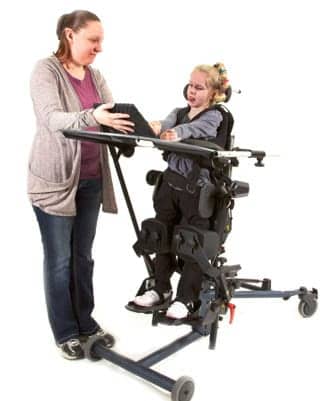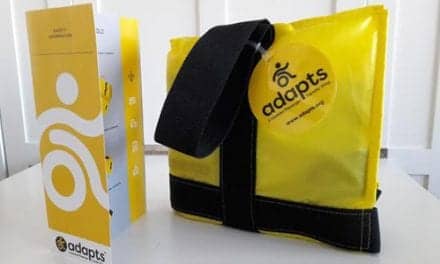Teaching mobility versus developing motor skills based on the developmental continuum.
by Michelle Fox-Hustwaite, MA, OTR/L, ATP
Upon researching developmental milestones for children, a variety of charts will be found that present physical, cognitive, communication, and social lists of skills. These lists include ages at which most children develop each skill. The Centers for Disease Control and Prevention, Easter Seals, and the American Speech-Language-Hearing Association (ASHA) provide such guidelines for children.
On each of these lists, sitting occurs by 8 months of age, crawling by 10 months, standing by 12 months, and walking by 14 months. For children affected by disabilities, these age ranges are often significantly delayed. For children affected by moderate or severe physical and/or cognitive disabilities, unsupported sitting, crawling, standing, and walking may not be physically possible.
Encouraging Movement
Parents expect their children to explore their environments. This typically begins with children mouthing their fingers and toes and expands to rolling, crawling, and standing. My question as a therapist is: why? Does a child go through the developmental continuum to learn how to move? Or does a child need to move to develop?
One of the first children I worked with, as a new therapist, was a 9-month-old boy with alternating hemiplegia. Tom had the equivalent of small strokes, which affected the right side of his body. He would lose function of his right leg and arm with each episode. He would regain movement of the right side of his body within hours or a day after the stroke had subsided. Family, caregivers, and therapists learned to observe the signs of a new stroke and could administer medication to reduce the severity.
Tom was happy and inquisitive when not affected by his neurological condition. However, he had spent many hours in intensive care units, hospitals, and his bed. His family was afraid to play with him as they did with his older sister.
During our first treatment session, Tom was hungry and his mother wanted to feed him. I asked if I could observe and problem-solve improved participation. In so doing, I realized Tom could bring his hands to midline while on his back. I placed the bottle in Tom’s hands and began to let go. He grasped with both hands for 5 to 10 seconds and then dropped it. Tom cried, and his mother jumped forward to retrieve the bottle. I gently explained to Tom’s mother I believed he could perform this task, and tried again. Tom’s mom later told me she thought I was being mean. She was, however, excited to see her son perform any task on his own.
We set our first goal. Tom would hold his bottle for at least 1 minute by himself. Luckily for me, food was a strong motivator for Tom. Unless affected by a hemiplegic episode, Tom eagerly held his own bottle independently within 3 months. Next we used the activity of getting the bottle as a motivator to roll and eventually stand.
During this time, we also introduced more movement experiences. Tom was provided a swing, and loved the slow rhythmical movement. His dad loved the concept of playing horse with Tom bouncing on his knee. We also used supported sitting to play with his sister and the dog. The more Tom moved, the more he wanted to move. But what about children who cannot initiate independent movement due to severe tone, syndromes, or cognitive delay? Nilsson et al explored ways to help people with profound cognitive disabilities (PCD) practice operating a joystick-operated powered wheelchair. They developed the Eight Phases of Growing Consciousness of Joystick Use to Operate a Powered Wheelchair. It is only at the third stage of “act” when an individual activates the joystick and gets the effect of motion that alertness increases and there is an exploration of cause and effect. Then, we see distinct, aimed movements that are self-initiated and voluntary.
Nilsson summarizes her findings: “Because they are hard to engage in any purposeful activity, people with PCD require assistance to reach higher levels of constructive activity. Attaining control of tool-mediated mobility is an empowering experience for the participant, and successfully using facilitating strategies is an empowering experience for the facilitator. As the participant becomes more conscious and more able to explore the vicinity, he or she becomes a doer—that is, a person with the desire and ability to learn how to actively influence and interact with the environment.”1
Armed with the ideal that self-initiated movement is a requirement for development, the next question is how do therapists provide these experiences to children affected by disabilities?
Equipment
Mobile corner sitters, gait trainers, and power wheelchairs can all be used to instill the sense of active movement and mobility in a child who is not developing motor skills at the same rate as peers. This is often initiated by an occupational therapist or physical therapist within a therapy session. The mobile corner sitter allows a child to explore his environment while in a supported, seated position. It has a V-shaped surface with a pommel for positioning of the lower extremities. Additional support can be added through a grab bar, head rest, or tray. The wheels are protected by rubber “bumpers,” which allow for cause and effect impact with the wall without damage.
Gait trainers come in many different shapes and sizes. They are generally referred to as posterior (behind the child), anterior (in front of the child), and dynamic. The posterior gait trainer is generally the least supportive. It may consist of four wheels and handlebars for a child to hold onto. It also may have a seat for the child to sit on to rest, interact with supplies at a table, or wash hands at a sink. This gait trainer may have support pads at the hips.
Anterior gait trainers are generally used for children who require more support. They often require hip support, lateral trunk supports, and forearm troughs/handlebars. The lower extremities may be supported by a harness or a saddle seat. Additional positioning is provided by leg separators or ankle straps to stop crossing of the legs while walking. It is difficult to access tables or sinks with an anterior gait trainer. Dynamic gait trainers support posteriorly at the hips and chest but do not have handlebars for the child to hold onto. The suspension system is weight relieving and allows a child to stand, flex the knees, and be supported while picking up and placing each foot. The supportive column located behind or in front of the child can be adjusted to move their weight slightly forward. Moving the child’s center of gravity forward makes it easier to initiate independent steps. These systems allow hands-free ambulation and access to toys, computers, and sinks. Dynamic gait trainers are available for children as young as 6 months of age.
Gait trainers have other options to aid in independent ambulation depending on a child’s needs. Directional locks prevent the castors from swiveling. This allows the gait trainer to move in a straight line. The child only has to control forward movement and not left or right variations. Resistance control brakes require more force to be used to initiate movement. This can be helpful with children with tone. One brake also can be set at a higher setting if a child is stronger on one side of the body than the other. The resistance can be set higher on the stronger side of the body. Anti-reverse wheel locks stop the gait trainer from moving backwards. Keeping the weight slightly in front of a child allows for easier movement, and in a direction the child can see.
Standing frames allow a child to experience upright posture, develop weight bearing, and play with items at chest height. However, they do not allow for active movement to get a toy across the room. Standing frames can be a valuable asset to the developmental process. A standing frame may be used in the home or school while additional therapy services focus on gait trainers or powered mobility to teach the concept of mobility. Power wheelchairs can be an important tool in developing the sense of independent mobility for a child with severe physical or cognitive needs. As discussed before, there is a significant difference between the sense of mobility and the ability to drive a power wheelchair.
“When looking at children driving a powered wheelchair, we need to determine what is meant by ‘driving’ and our expectations for these children. Normally developing children start exploring their environment at 3 to 4 months of age via reaching and rolling. Creeping at 7 to 9 months of age allows discovery of further distances, with resultant changes in perceptual, cognitive, and socioemotional behavior. At 12 to 13 months, children typically begin to walk. Therefore, utilization of powered mobility at similar ages is also recommended for the appropriate children, to enable them to explore the environment and in turn continue to develop motor and cognitive skills.” 2
Lisa Rotelli and Karen Kangas outlined wheelchair configuration strategies in their presentation, “Configuring Powered Mobility Systems for the First Time User,” at the 2013 International Seating Symposium.
The physical configuration of the wheelchair must support independent control and mobility. Seating is for function and not for control of tone. It may require the removal of most postural supports such as armrests, footrests, and chest supports. The size of the wheelchair should be proportionate to the size of the child. There are small powered wheelchairs with 6 x 6-inch seating systems available.
Choice of driving input should simplify the process of driving. Switches have one speed and direction and consistently perform the same movement. Joysticks allow control of direction and speed, which vary significantly depending on how the joystick is moved. Switches placed in a head array associate movement with visual tracking. Even individuals who are able to walk look where they want to go. There should be no delay from when the input device is activated to when the chair begins to move. Initial speeds should be slow, no faster than the child could creep or walk.2
Supervised Mobility
Learning mobility is a supervised experience. Children should learn to drive in a familiar environment. The ability to stop will develop as gentle bumps occur. We let the toddler fall or cringe as she bumps her head while trying to stand up under the coffee table. We also should allow bumps to occur in an appropriately programmed power wheelchair with a supervising adult. As we would not let a child run into the street, we should have the ability to stop the power wheelchair if a true emergency occurs. Be sure to explain to the child what happened and manually move the power wheelchair to a safe location.
Mobility is about the experience and freedom of movement. Expect that the child meant to complete each movement that happens. Normally developing children love to spin. Most children (and my normally developing niece and nephew) turn circles in a power wheelchair when driving. Let her be in control! It is most likely the first time this girl has experienced true freedom of movement. Let her move, bump, and most of all play. Never forget, play is a child’s true occupation! RM
Michelle Fox-Hustwaite, MA, OTR/L, ATP, received her Masters in Occupational Therapy from the University of Southern California. She has specialized in sensory integration and assistive technology for individuals of all ages. She and her husband, David, own Aspen Rehab Solutions Inc and educate therapists and providers on adaptive equipment in multiple states. For more information, contact [email protected].
References
1. Nilsson L, Eklund M, Nyberg P, Thulesius H. Driving to learn in a powered wheelchair: the process of learning joystick use in people with profound cognitive disabilities. Am J OccupTher. 2011;65:652–660.
2. Rosen L, Arva J, Furumasu J, et al. RESNA position on the application of power wheelchairs for pediatric users. Assist Technol. 2009;21:218–226.






